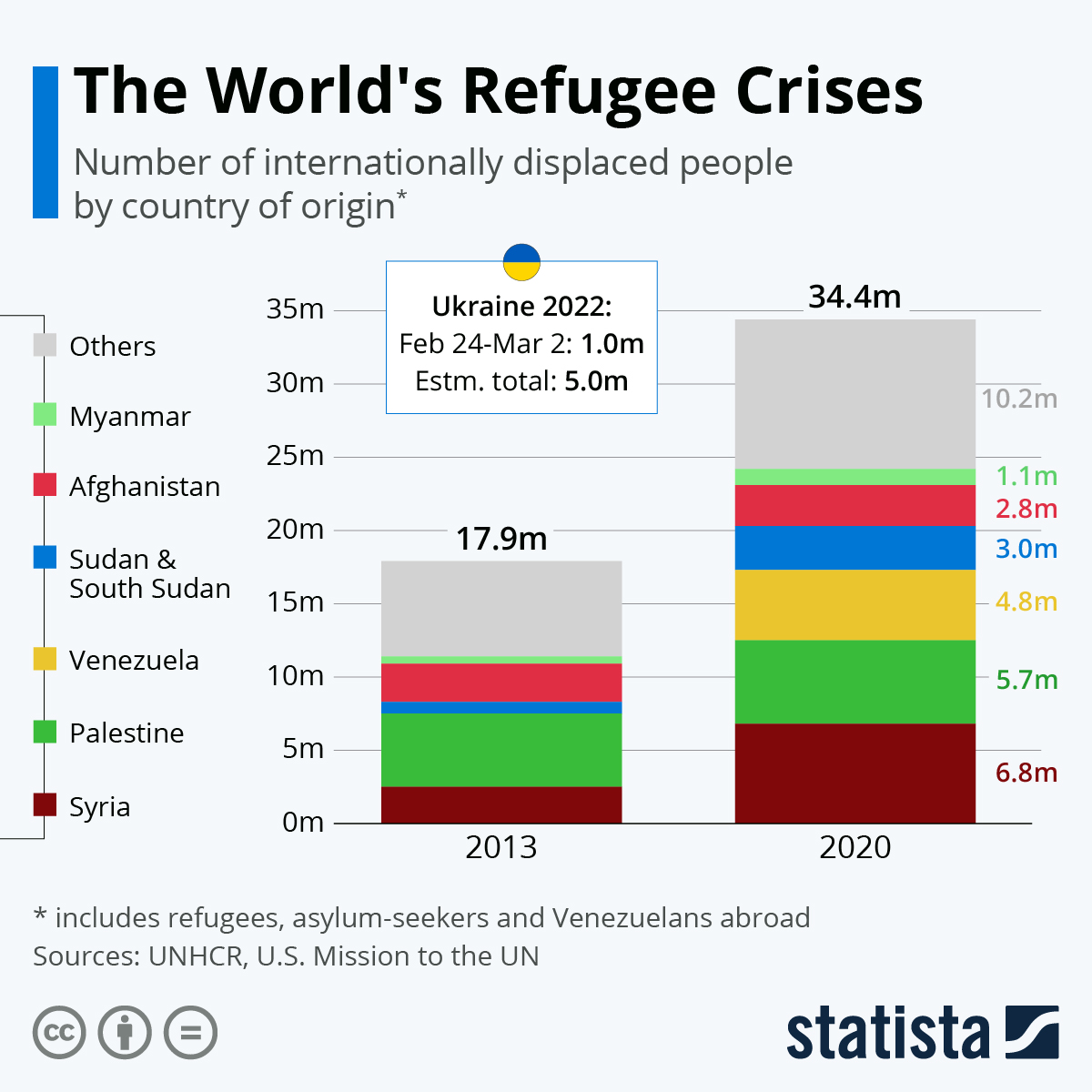Russia-Ukraine Conflict: Increased US Presence In Northern Europe

Table of Contents
Reasons for Increased US Military Presence in Northern Europe
The surge in US military assets in Northern Europe is a multifaceted response to the evolving security situation. Several key factors underpin this strategic decision.
Deterrence against Russian Aggression
The primary driver for the increased US military presence is to deter further Russian aggression in the region, following the 2022 invasion of Ukraine. The Kremlin's actions have shattered previous assumptions about European security, prompting a reassessment of defensive strategies. Increased troop deployments and large-scale military exercises serve as a visible demonstration of US commitment to NATO allies and a clear message to Moscow.
- Deployment of additional troops: Significant numbers of US troops have been deployed to Poland, the Baltic states (Estonia, Latvia, Lithuania), and Norway. These deployments bolster the defensive capabilities of these frontline NATO members.
- Enhanced military exercises: Joint military exercises involving US forces and NATO partners have increased in frequency and scale, enhancing interoperability and readiness. These exercises showcase the alliance's collective strength and resolve.
- Pre-positioning of equipment and supplies: The US has pre-positioned substantial amounts of military equipment and supplies in Northern Europe, enabling a rapid response to any potential aggression. This forward positioning significantly reduces response times in case of an emergency.
Strengthening NATO Alliances
The Russia-Ukraine conflict has underscored the critical importance of collective defense within the North Atlantic Treaty Organization (NATO). The increased US military presence reinforces the alliance's commitment to Article 5, which mandates mutual defense in the event of an attack on any member state. This visible demonstration of solidarity aims to strengthen the alliance's cohesion and deter potential adversaries.
- Increased joint military training and cooperation: US forces are actively engaged in enhanced joint training and exercises with NATO allies, improving coordination and interoperability.
- Improved intelligence sharing and coordination: The US is sharing intelligence and coordinating defense strategies with NATO allies more closely than ever before, strengthening collective situational awareness.
- Strengthened political dialogue and collaboration: The conflict has fostered stronger political dialogue and collaboration among NATO allies, reaffirming the alliance's core principles and commitment to collective security.
Addressing Security Concerns of Neighboring Countries
The conflict has heightened security concerns among countries bordering Russia and Ukraine. These nations feel increasingly vulnerable to Russian influence and potential aggression. The US presence provides reassurance and practical support to these nations, helping to mitigate their anxieties and bolster their defenses.
- Increased security assistance to vulnerable countries: The US is providing increased security assistance, including financial aid, training, and equipment, to countries considered most at risk.
- Provision of advanced military equipment and technology: The US is supplying advanced military equipment and technology to bolster the defensive capabilities of its allies in the region.
- Enhanced cybersecurity cooperation: Cybersecurity threats have increased dramatically, prompting enhanced cooperation between the US and its allies in Northern Europe to defend against cyberattacks.
Implications of Increased US Military Presence
The increased US military presence in Northern Europe carries significant implications across various domains.
Geopolitical Implications
The shift in the US military posture has significant geopolitical consequences. It undeniably alters the regional power balance, potentially leading to heightened tensions with Russia. The Kremlin's response will be crucial in determining whether this leads to further escalation or, conversely, a cautious de-escalation.
- Increased risk of accidental conflict or miscalculation: The increased military presence raises the risk of accidental conflict or miscalculation, requiring careful management of military operations and communication channels.
- Potential for a new Cold War dynamic: Some analysts predict the potential for a new Cold War dynamic, characterized by increased geopolitical rivalry and a renewed arms race.
- Increased diplomatic efforts to manage the situation: The increased tensions necessitate intensified diplomatic efforts to manage the situation and prevent further escalation.
Economic Implications
The heightened security situation translates into increased military spending by both the US and European nations. This has wide-ranging economic impacts, both positive and negative.
- Increased military spending: Significant investment is being directed towards defense infrastructure, technology, and personnel.
- Opportunities for defense contractors: The increased military spending creates opportunities for defense contractors, stimulating economic activity in the sector.
- Potential strain on national budgets: The substantial increase in military spending can place a strain on national budgets, potentially diverting resources from other vital sectors.
Social Implications
The increased US military presence has noticeable social implications within Northern Europe. Public opinion regarding both the US and Russia is likely to be influenced, impacting domestic political dynamics.
- Impact on public opinion: Public opinion in Northern Europe towards the US and Russia will be significantly shaped by this development, influencing political discourse and public perception.
- Potential impact on migration and refugee flows: The ongoing conflict and the heightened security situation may affect migration and refugee flows into and within Northern Europe.
- Increased public debate on defense spending and security: The increased US military presence will fuel public debate on defense spending, security policies, and the overall geopolitical situation.
Conclusion
The increased US military presence in Northern Europe, a direct consequence of the Russia-Ukraine conflict, presents a complex and evolving situation with profound geopolitical, economic, and social implications. Understanding the underlying reasons for this shift, as well as its potential ramifications, is essential for navigating this volatile period. The future trajectory of this increased US presence will depend heavily on the evolving dynamics of the conflict and the responses of both Russia and the international community. Staying informed about the Russia-Ukraine Conflict: Increased US Presence in Northern Europe is crucial for comprehending the future security landscape of the region. For continued in-depth analysis and up-to-date information on this critical topic, we encourage further research into the evolving situation and its enduring impact.

Featured Posts
-
 Middle Management Unlocking Value For Businesses And Their Teams
May 28, 2025
Middle Management Unlocking Value For Businesses And Their Teams
May 28, 2025 -
 Ayndhwfn Ytwj Blqb Aldwry Alhwlndy Llmwsm 2023 2024
May 28, 2025
Ayndhwfn Ytwj Blqb Aldwry Alhwlndy Llmwsm 2023 2024
May 28, 2025 -
 Man Utds Garnacho Linked With Liverpool After Amorim Decision
May 28, 2025
Man Utds Garnacho Linked With Liverpool After Amorim Decision
May 28, 2025 -
 Hamburg Tournament Added To Sinners Return From Doping Ban
May 28, 2025
Hamburg Tournament Added To Sinners Return From Doping Ban
May 28, 2025 -
 34 Million Euro Millions Draw Live Results For Tuesday April 15th
May 28, 2025
34 Million Euro Millions Draw Live Results For Tuesday April 15th
May 28, 2025
Latest Posts
-
 Scary Movie 6 Reviving Iconic Characters Through Current Horror Tropes
May 29, 2025
Scary Movie 6 Reviving Iconic Characters Through Current Horror Tropes
May 29, 2025 -
 Increasingly Disturbing Trailers For The Talk To Me Supernatural Horror Sequel
May 29, 2025
Increasingly Disturbing Trailers For The Talk To Me Supernatural Horror Sequel
May 29, 2025 -
 Bring Her Back Trailer Sally Hawkins Terrifies In Talk To Me
May 29, 2025
Bring Her Back Trailer Sally Hawkins Terrifies In Talk To Me
May 29, 2025 -
 The Disturbing Trailers For The Talk To Me Sequel Build Anticipation
May 29, 2025
The Disturbing Trailers For The Talk To Me Sequel Build Anticipation
May 29, 2025 -
 Could Cindy And Brenda Return In Scary Movie 6 Exploring The Latest Horror Trends
May 29, 2025
Could Cindy And Brenda Return In Scary Movie 6 Exploring The Latest Horror Trends
May 29, 2025
